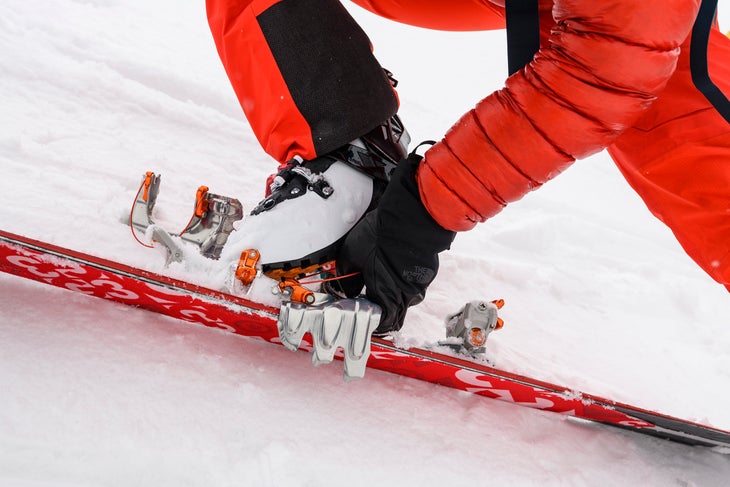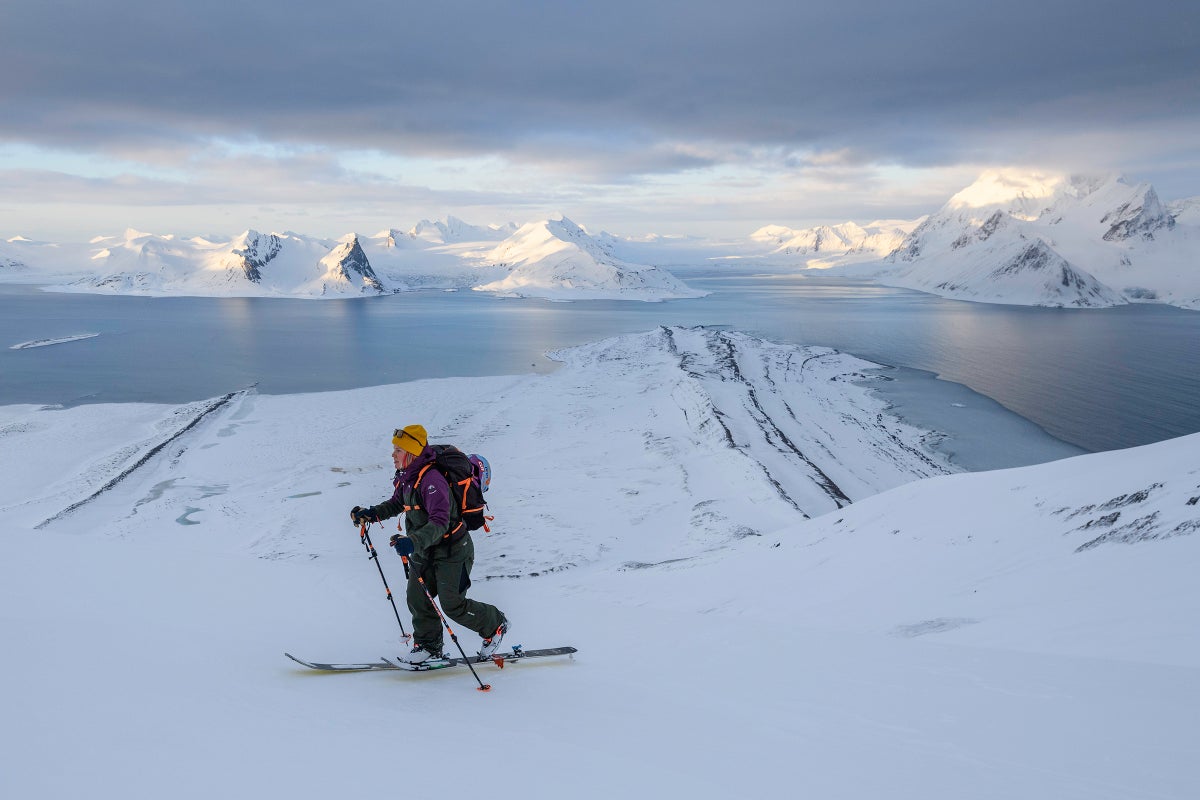Products You May Like
Heading out the door? Read this article on the new Outside+ app available now on iOS devices for members!
Download the app.
Decades ago, I frequently skied in the backcountry with my friend Tyler who preferred to snowboard. Splitboard technology wasn’t yet “the answer,” so Tyler used snowshoes for the ups and had to work twice as hard to keep up.
But there was this one time in Colorado’s Blaine Basin when the tables turned. The San Juan mountains had a “snirt” layer that season—a layer of brownish-red snow created by dust rustled up by cattle runs and windstorms—that gunked up my skins and eliminated all grip on the ascent. A less-than-optimal freeze at that elevation the night before also forced us to periodically take off skis and hike in boots, which in turn led to knee-deep post-holing.
While the skiers in our party waddled awkwardly on edges and unsuccessfully tried to avoid uphill face plants, Tyler’s snowshoes provided the perfect amount of surface area to prevent sinking into the snow, while the spikes underfoot penetrated the snirt and provided grip. Even Tyler was shocked by how far ahead he was by the time we arrived at the bottom of Mount Sneffels’ East Couloir.
What I didn’t have at the time but desperately needed to keep up with Tyler were ski crampons.
What Are Ski Crampons?

Ski crampons are pieces of aluminum or steel that connect to a touring binding and provide added traction when touring on hard snow.
“…[S]ki crampons have teeth on either side of the ski and provide ‘bite’ into the snow, like a boot crampon,” writes Rob Coppolillo in his book, The Ski Guide Manual. “Paired with skins, they provide exceptional grip on the up.”
Every brand that makes a touring binding makes a compatible ski crampon, and there are a few brands that make ski crampons that are compatible with a variety of bindings. SkiMo Co., a ski shop in Utah, explains every type of ski crampon and cross-compatibility in this post.
Why You Need Ski Crampons
If the snow is too hard for your skins to get a solid grip at a moderate incline, ski crampons are the solution. This is most common in the spring when the snow softens during the day but freezes at night, but can also be caused by wind events and other factors. Ski crampons can also provide added assurance in exposed terrain.
“Harcheisen—German for ski crampons—are a valuable tool for ski mountaineering and spring skiing missions,” echoes Matthew Lipscomb, an AMGA-certified ski guide for the Colorado Mountain School. “They are an effective means to add protection for moderate slope angle and firm snow conditions when the consequences of a slip become unacceptable, when the terrain is not yet steep enough for boot crampons, or for short steeper sections, like a convexity, between low angle terrain.”
Even after my humbling experience of being beaten by a snowboarder in Blaine Basin, I still spent the following decade thoroughly convinced that ski crampons were unnecessary. I ignored the calls to bring them on trips to Oregon, Norway, and Kyrgyzstan. I told myself it’s just as efficient to put on regular crampons and walk if conditions warrant that level of grip.
“I know a lot of people say, ‘if it gets that hard, I’ll just put on boot crampons,’” says AMGA-certified guide Mike Hattrup. “Aside from having to carry your skis instead of sliding them, there are some good reasons why this isn’t always efficient.”
Hattrup recalls a time when he was leading clients up Mt. Shasta. “It had snowed about a foot a couple of days earlier and there was a supportable crust if you were on skis,” he says. “But because a couple of clients didn’t have ski crampons, we all switched to boot crampons. It took one kick to break through the crust, one more to compress most of the consolidated snow underneath, and one more to have a solid platform that didn’t move when fully weighted. I essentially climbed 15,000 feet when we could have been gliding along. It was so brutal that other parties were intentionally losing 300-400’ of vertical from their route to follow our boot track.”
As a result, Hattrup swore he’d leave clients behind if they didn’t bring ski crampons on ski touring trips.
How to Use Ski Crampons
The most important factor is knowing when you’ll need ski crampons in advance, and making sure they are handy enough so you don’t have to take off your pack to retrieve them.
“With a bit of practice, they can quickly be deployed or stowed—much faster than a full transition to boot crampons,” says Lipscomb. “Planning the ascent in advance, anticipating slope angle and snow firmness, and having ski crampons readily accessible when they will likely be needed can save time, energy, and stress on the climb.”
Lipscomb recommends securely attaching your ski crampons to your backpack’s waistbelt. Coppolillo takes this practice a step further by putting them in a duct-tape reinforced stuff sack that can be clipped to your pack. This should prevent the ski crampon’s teeth from biting into you in case of a fall.
Watch: How and When to Use Ski Crampons
When Covid was still running rampant, I found myself spending a lot of time exploring Colorado’s Indian Peaks, the closest mountains to where I live on Colorado’s Front Range. A new friend with deep experience in these mountains noted that the east-facing snow in May warrants ski crampons. I was also well aware of the rolling convexes of terrain and the crust that can develop at different elevations. Somewhat reluctantly, I figured I should finally give crampons a go.
A borrowed pair of G3 crampons changed my opinion on ski crampons for good. I could still glide forward efficiently while side-hilling on rock-hard refrozen snow and had enough grip to keep upright on tricky slopes. I used them on every ski tour that spring, and now make sure I have a pair that live comfortably alongside my boot crampons in a sturdy case that accommodates both.
